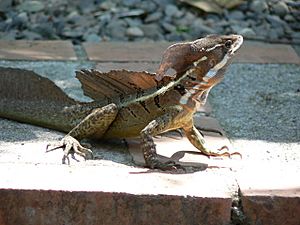Common basilisk facts for kids
Quick facts for kids Common Basilisk |
|
|---|---|
 |
|
| Male near Manuel Antonio National Park, Costa Rica | |
| Scientific classification | |
| Kingdom: | |
| Phylum: | |
| Class: | |
| Order: | |
| Suborder: | |
| Family: |
Corytophanidae
|
| Genus: | |
| Species: |
B. basiliscus
|
| Binomial name | |
| Basiliscus basiliscus (Linnaeus, 1758)
|
|
The Common Basilisk (Basiliscus basiliscus) is a fascinating type of lizard. You can find these cool reptiles in the warm, wet rainforests of Central and South America. They especially love to live near rivers and streams.
This amazing lizard is part of the corytophanid family. It has a very famous nickname: the "Jesus Christ Lizard." This is because it has a super cool trick – it can actually run across the surface of water!
Contents
Common Basilisk: The Jesus Christ Lizard
The Common Basilisk is one of the most interesting lizards around. It's known for its incredible ability to run on water. Imagine seeing a lizard sprint across a pond! This special skill has earned it its famous nickname.
These lizards are usually found in the steamy, green rainforests. They spend a lot of their time in trees, but they are always ready to dive into water or run across it if danger appears.
Running on Water: How Do They Do It?
So, how does the Common Basilisk run on water without sinking? It's all about speed and special feet! When a basilisk runs, it moves its legs incredibly fast. Its back feet have special fringes, or flaps, on their toes.
When the basilisk's foot hits the water, these fringes spread out. This creates a larger surface area, like a tiny paddle. The lizard pushes down hard and fast, creating a small air pocket under its foot. This air pocket helps to support its weight for a split second. Before the foot can sink, the basilisk lifts it and puts the next foot down. It's like a rapid-fire series of slaps on the water! This amazing trick allows them to run for about 10 to 20 meters (33 to 66 feet) before they have to start swimming.
What Does a Basilisk Look Like?
Common Basilisks are usually bright green, but they can also be brown or olive. This color helps them blend in with the leaves and branches of the rainforest. Males are often more colorful than females. They also have a large crest, or fin-like structure, on their head and back. This crest makes them look even more impressive. Females have smaller or no crests.
These lizards can grow to be quite long, including their tail. An adult basilisk can reach up to 80 centimeters (31 inches) in length, but more than half of that is usually their long, whip-like tail. They have big eyes and a pointed snout.
Where Do Basilisks Live?
Common Basilisks are native to the tropical rainforests of Central and South America. You can find them in countries like Costa Rica, Panama, Nicaragua, and Colombia. They prefer areas with lots of trees and close to water sources like rivers, streams, and ponds.
They are arboreal, which means they spend most of their lives in trees. They are excellent climbers. However, they are always close to water, which is their escape route from predators. If a snake or a bird of prey tries to catch them, they can quickly drop into the water and run away.
What Do Basilisks Eat?
Common Basilisks are omnivores, which means they eat both plants and animals. Their diet mostly consists of insects like crickets, grasshoppers, and beetles. They also eat spiders.
Sometimes, they might snack on small fruits or flowers they find in the rainforest. Young basilisks tend to eat more insects, while older ones might add more plant material to their diet. They are good hunters and use their sharp eyesight to spot prey.
Fun Facts About Basilisks
- Basilisks are very fast runners, even on land. They can reach speeds of up to 11 kilometers per hour (7 miles per hour).
- They are also excellent swimmers and can stay underwater for a long time if needed.
- The name "basilisk" comes from a mythical creature, a serpent king said to have deadly breath and the power to kill with a glance. Luckily, the real basilisk lizard is harmless to humans!
- They are active during the day, which means they are diurnal.
- When they feel threatened, they might stand up on their hind legs and run away, which looks pretty funny!
See also
 In Spanish: Basilisco común para niños
In Spanish: Basilisco común para niños

